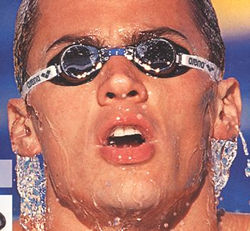|
Chlorine |
||
| WATER The Water Cycle Water in a Pool Water compared Pool Processes POOL PROCESSES CHEMISTRY IN OZONE DISINFECTION NEW IDEAS Hannah Morgan, University of Bristol, School of Chemistry, hm9921@bris.ac.uk |
Chlorine and hypochlorite react with pollutants to form other products. Ammonia is introduced into the pool by the decomposition of sweat and urine. This is slow and produces chloramines which are measured as combined chlorine. The first stage is: Cl2 + NH3 > HCl + NH2Cl The monochloriamine produced (NH2Cl) is stable, but is an ineffective disinfectant. With enough chlorine, this is further decomposed to dichloromine, NHCl2 , which irritates the nose and eyes. Cl2 + NH2Cl > HCl + NHCl2
Goggles can be worn to stop the irritants reaching the eyes Dichloroamine is unstable if the pH is within the pool range, so with excess chlorine, this reacts and produces a reaction to form acid and nitrogen gas. NH2Cl + NHCl2 > 3HCl + N2 This is known as breakpoint chlorination. The combined chlorine level drops, the free chlorine level rises. This process will happen as long as the free chlorine level is higher than, for example double the combined level. The free chlorine level should be less than 1 mg/l. In cases where the pH is too low and the chlorine levels are too high, nitrogen trichloride is produced. Cl2 + NHCl2 > HCl + NCl3 These are organic chloramines which are dangerous in their own right. An important point to note is that all these reactions are slow so it may be necessary in the case of severe pollution for the water to be left for a few hours to ensure complete removal and re-circulation. |
